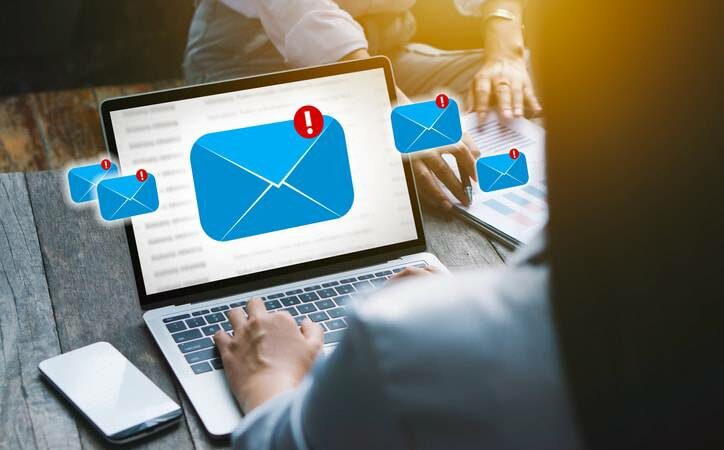If you’re looking for ways to improve your reach and increase sales, consider ecommerce email marketing. According to a 2023 survey by Litmus, a staggering 41% of marketers said email marketing is their most effective channel, surpassing social media and paid search.
According to a Statista report, more than 70% of U.S. consumers want to be contacted by brands via email. So why not give the people what they want? Here are some top tips to help you get the most out of your ecommerce email marketing strategy.
What is ecommerce email marketing?
Ecommerce email marketing is the practice of reaching consumers through a strategic series of emails. It covers only one part of your overall ecommerce strategy. Your targeted audience can be current customers, former customers, or people who have simply shown an interest in your brand.
With email marketing, you send a variety of messages to grab your reader’s attention. Examples of this include abandoned cart emails, weekly newsletters, automated welcome emails, membership or VIP offers, and more. The goal of ecommerce email marketing is to encourage customers to support your brand through new sales.
Why ecommerce email marketing is important
There are many reasons why small businesses should consider ecommerce email marketing. Even if you don’t have the resources to hire your own email marketing team or invest in the best email marketing software, your business can still gain several benefits, including:
Email can improve your return on investment (ROI)
Investing in email can pay off big time. The ROI for ecommerce email marketing is approximately $44 per dollar spent. This far exceeds the ROI for paid advertising and ecommerce search engine optimization (SEO), which are $2 per dollar spent and $2.75 per dollar spent, respectively. This doesn’t mean you should put all your marketing dollars into email, but you should increase your focus toward it.
The Number of Email Users is Growing
Email is becoming more and more popular. There will be 4.26 billion email users in 2022, and that number is expected to grow to 4.73 billion by 2026. Meanwhile, Facebook’s number of users is expected to remain at 3.1 billion by 2027. If you want to get where the people are, look no further than email.
More Businesses are Using Email
Research shows that 64% of small businesses use email marketing to reach their customers. If you don’t want to be left behind, you have to get involved; otherwise, your customers might turn to other companies.
Increasing brand awareness through email
For almost 86% of email marketers, the main goal of their campaigns is to increase brand awareness. Sending timely and relevant emails can help inform customers about offers and keep your products top of mind when it comes time to buy.
14 E-Commerce Email Marketing Tips to Grow Your Business
Ready to launch a successful email campaign? Use these tips to take your eCommerce email marketing to the next level:
1. Use email marketing software
Before you get started, we recommend investing in email marketing software that helps you manage all your campaigns, audiences, and click-through rates (CTRs). This makes it much easier to create emails and send them to specific customers and see which emails are most effective. Mailchimp is our top choice for all-in-one marketing. Another option is Constant Contact, which offers a variety of pricing plans depending on your business needs. However, there are plenty of alternatives to consider.
2. Use abandoned cart emails
When someone approaches the checkout but doesn’t finish their purchase, it’s like a fish on a hook. You know exactly what your customer wants to buy, so use that to your advantage and capture them. Send abandoned cart emails to remind them of what they missed out on. 50% of users who click on abandoned cart emails complete their purchase, making them effective at closing the deal.
However, you don’t want to overwhelm your target group. Limit your cart abandonment emails to three total: one within a few hours of abandonment, one the next day, and one the day after that.
3. Send discounts and special offers
Give customers a reason to stay on your email list, such as offering a chance to receive a discount or discount.
Frequently offer special offers or discounts that are only available through email. It could be something simple, like a 10% discount code for signing up for our newsletter. Or it could be something more exclusive, like access to a special edition product or experience.
4. Always include a call to action (CTA)
Your email should always have a purpose, whether it’s encouraging customers to buy a specific product or view a new blog post. Make this CTA clear and easy to understand.
For example, if you want customers to check out your new product line, include a clear link to that product line and enticing text that makes the reader want to learn more. On average, email CTAs have a CTR of 3%-5%, which is much higher than Facebook Ads (1.1%-1.3%) and Google Ads (0.05%).
5. Segment your target group
One of the most important tasks before sending an email is to segment your target group. Around 78% of marketers believe this is the most effective strategy for email marketing campaigns.
Segment your audience by organizing them by customer type. For example, you can create individual email campaigns based on customer demographics, previous purchase history, product interests, and even their response to previous email campaigns.
Once you identify these different audiences, you can create custom content tailored to their needs. You can send extra bonuses and offers to your VIP customers, or pitch more expensive products to customers with a long buying history. The possibilities are endless.
6. Personalize your emails
With this in mind, you should make sure to personalize your emails. 72% of marketers rated this as the most effective email marketing strategy. Of course, this means calling your customers by their name, but you can go beyond that. Through dynamic content, you can reference products they’ve previously purchased or are interested in.
Around 64% of emails use dynamic customization. Personalizing your content makes your emails more human and less generic, helping customers build trust and loyalty with your brand.
7. Create a compelling subject line and preview it in the email
Your subject line may be your only chance to score. You can create the most well-worded email message in the world, but if your subject line is boring, spammy, or irrelevant, your customers won’t even open it to check out the content.
Two of the most important strategies to consider are personalization and emojis. Today, 60% of email marketing teams use personalization in subject lines to capture consumer interest, and 58% use emojis to add fun to the inbox.
Don’t forget the first line of your email; these often appear in email previews in modern mailboxes. Make sure your message is compelling and exciting, perhaps with a little cliffhanger so that readers have to click through your message to find the answer to their question.
8. Design emails for both mobile and desktop users
There are more mobile users than ever before, but that doesn’t mean everyone has given up on desktop computers. The solution? Create beautifully designed emails that work perfectly in either format. It’s a strategy used by 63% of email marketers. You can maximize your chances of success by making your email accessible to everyone, no matter where they read it.
9. Try A/B Testing
A/B testing is a way to find out which version of an email works better. Send two versions of your email: a control version that uses a common strategy, and an experimental version where you change only one element. Then track the results of each email to see which email garnered more interest.
The most common elements that marketing teams A/B test in emails include subject line personalization, emojis in subject lines, animated GIFs or PNGs, but they can also be used to test different CTAs, font sizes, color schemes, and more.
10. Preview your emails before sending
This tip should go without saying, but we know how hectic things can get when you’re pressed for time. Always preview your emails before sending to make sure all the spelling is correct, your customizations work properly, and all your images load properly.
If your emails are full of typos and broken links, your customers won’t take you seriously. We have research to prove it: Companies that regularly tested all their emails before sending had an average ROI of 6% higher than those who didn’t.
11. Invest in Automation
Email automation campaigns are ranked as the most important email marketing campaign tactic by 71% of marketers. And for good reason: they make your life a lot easier. Instead of manually creating and sending each message, email automation services can create abandoned cart emails, product reminders, and even out-of-stock notifications for you. You can even set up welcome drip campaigns that are automatically sent to all new members of your email list.
12. Avoid Spam with Your Email List
Receiving 12 messages from the same firm every day is annoying for anyone. It is advisable to keep the emails you send to a manageable amount. According to research, the ideal range is between two and four emails every week, or nine to sixteen emails per month.
But don’t make the mistake of not sending enough emails. Sending just one email a month has a lower ROI than sending 33+ emails a month. Staying consistent without getting overwhelmed is key to staying top of mind.
13. Think carefully about design elements
Email is more than just a relevant message. It’s also about the visual experience. You want your emails to look great and reflect your brand in a positive way. One area where many companies don’t optimize is creating emails specifically for dark mode. Up to 40% of people use this mode when viewing emails, so if your message is all black text, it may not even be readable.
You might also consider incorporating multimedia into your emails. Nearly 50% of marketers said that adding a video to an email slightly improves email performance.
14. Test Out Artificial Intelligence (AI)
AI is a hot topic in the marketing world, so it’s no wonder that many email marketers are starting to use it to craft subject lines, copy, and even CTAs. It looks like AI could help, as 56% of marketers say that content created with AI is more effective than content created without it.
But that doesn’t mean you should jump headfirst into the robot train. A study on AI found that 64% of consumers are concerned about the use of AI in personalized ads, meaning you might lose confidence if you rely too much on this tool.
Conclusion
Email marketing in e-commerce is a great strategy for converting consumers into customers. It’s also a great way to foster brand awareness and trust among former customers. But getting started isn’t always easy. Creating and sending your first email to your subscribers can seem daunting. But with these ecommerce email marketing tips, you’ll be set to create an email experience your followers will love.
- Midwestern State Wins 2025 NCAA DII Men’s Soccer Championship Final - December 15, 2025
- Jerry Rice Award History: Every Winner of the FCS Freshman Award - December 13, 2025
- When Do New Episodes of Taylor Swift’s The End of an Era Drop? | Schedule, Dates & Updates - December 13, 2025




